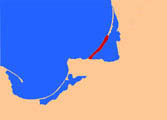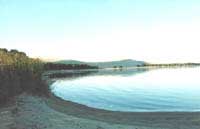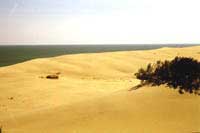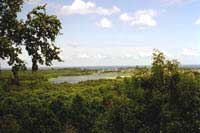
Project Polessk Curonian Spit (Ru) Curonian Spit (Lt) Nemunas Delta
CURONIAN SPIT (RU) |
| National Park of Russia Curonian Spit Ecotourism Info-Centre Lesnoj (de) Costs & Useful (de) |
|
|
|
Where elks wander through the forests ... |
|
| Gigantic dune formations, long sandy beaches and beautiful forests await you on your visit to the Curonian Spit. This area, about 100 km long in total, is divided into a Lithuanian and a Russian part. The constant change in the landscape will provide you with endlessly new impressions. The spit, created several thousand years ago by the activity of the waves against the sand, keeps on changing to this day, due to the constant influence of wind, weather and water flow. Man, too, has played a decisive role in forming the appearance of the spit today. The clearing of virgin forests caused the sand to shift, creating giant dunes which buried houses, fields and paths. It was only in the 19th century that people were able to stop the sand drifts, largely by planting grass and trees. Today, both the Russian and the Lithuanian part of the Curonian spit are UNESCO world heritage sites because of their cultural value. Elks live in the forests today, cranes and sea eagles brood here. During the bird migration in the Spring and Autumn, the Curonian Spit is one single bird stopping point. It is exceptionally important not only for breeding birds, but also as an rest area for migratory birds. In 1901, German ornithologists founded the first important ornithological station in Rossitten, today called Ribachi. For the first time, birds were systematically ringed for the purpose of investigating their behaviour during migration. From observation towers, you can let your eye wander over the spit and experience impressive moments of the bird migration. Nature trails lead you to the most beautiful parts of the Russian National Park: through the ”King’s Forest” with extensive pine and fir forests, to the ”Efa-Dune”, the highest drifting dune in the Russian spit area, to the so-called ”Island”, the oldest part of the spit, or to ”Swan Lake” with its many fish. With a boat, you can discover picturesque corners and typical fishermen’s houses surrounded by reeds. In the ecotourism info-centre in Lesnoj, you can get information about private accommodation and leisure activities. You can book boat and trekking tours and guided excursions here. Or you can visit the natural history museum and the ornithological station on the spit. |
   |
| Source: Folder "Ecotourism around the Vistula and Curonian Lagoons" | |
|
|
|
© 2002 by Mark Herrmann - berlin@bte-tourismus.de - Imprint